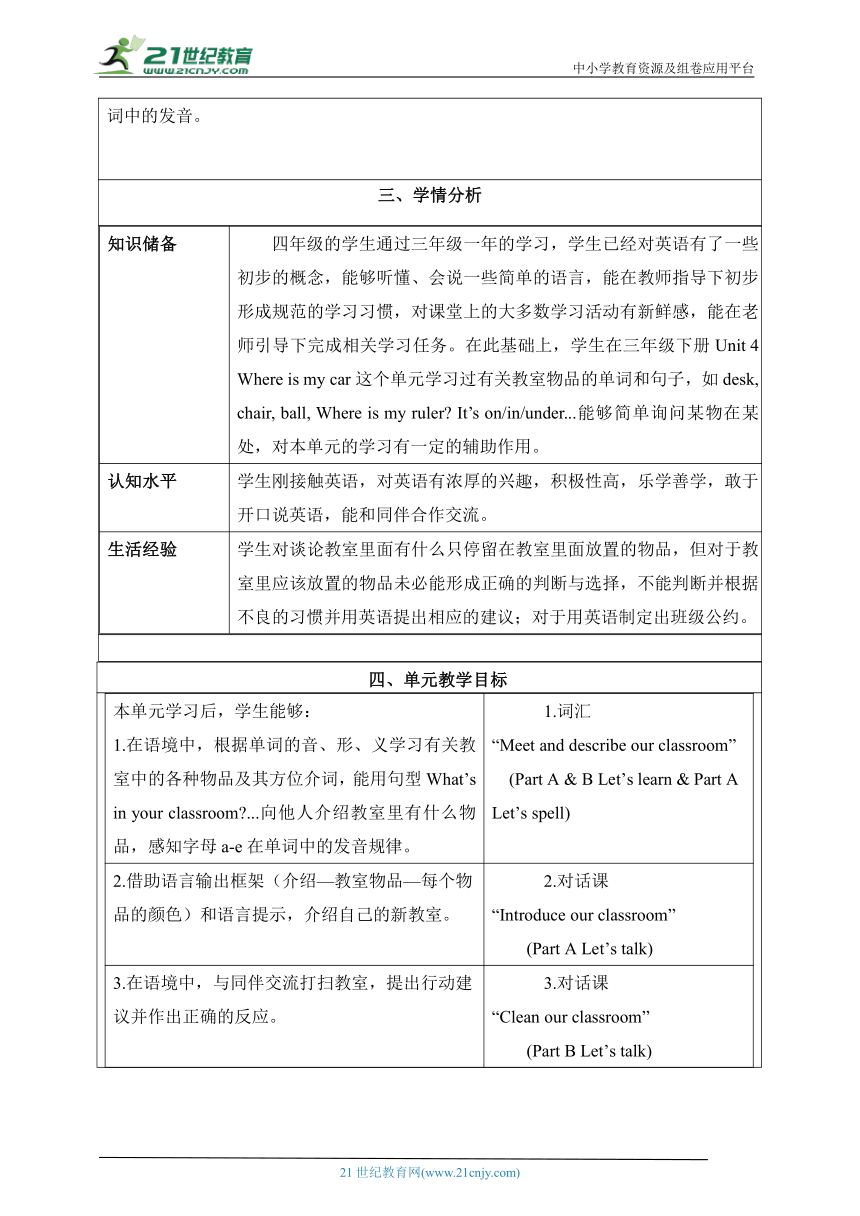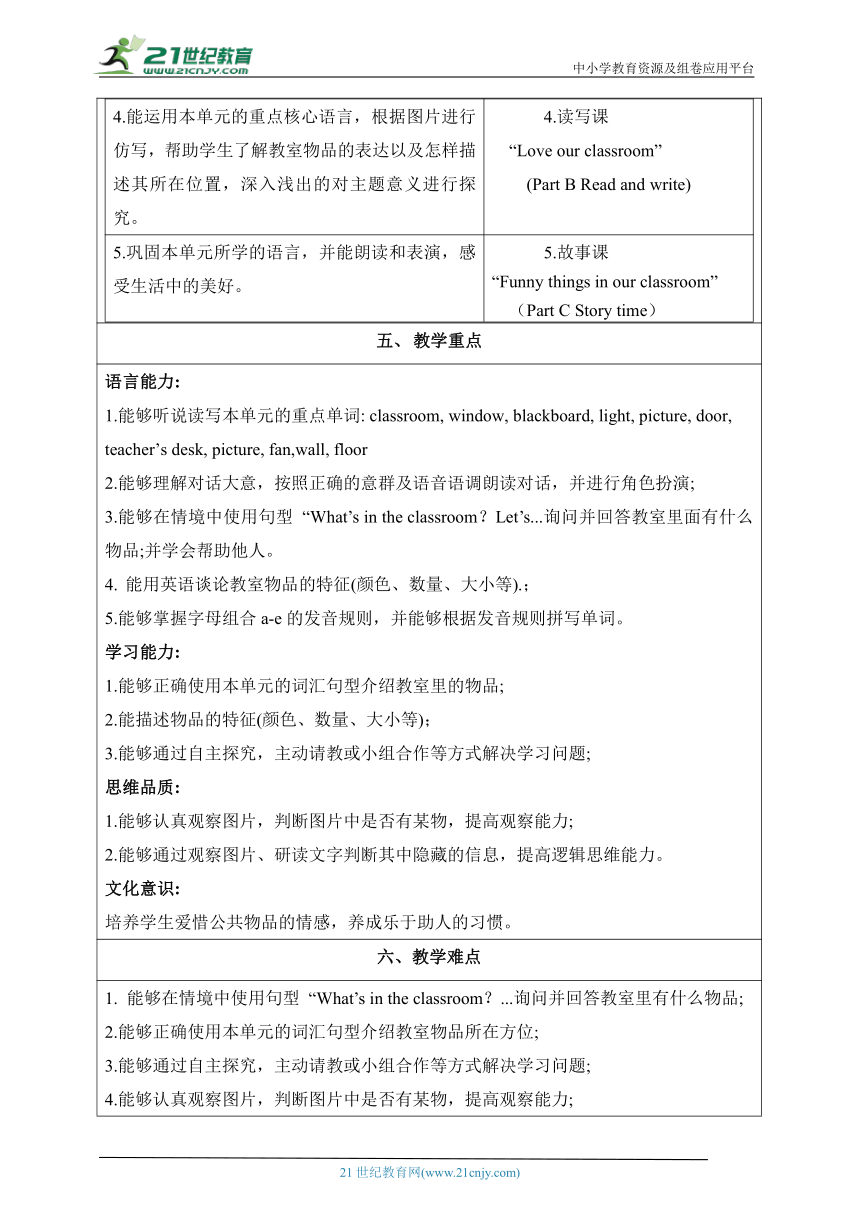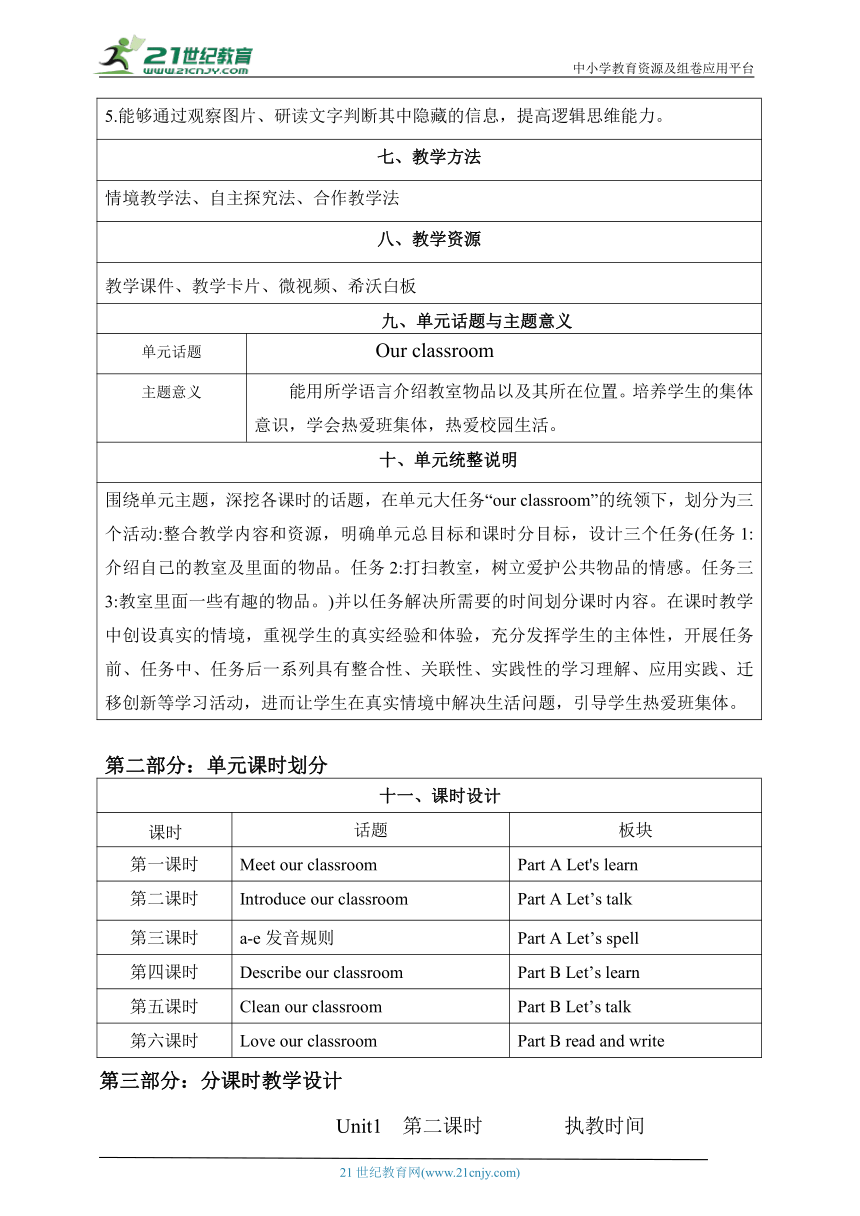Unit 1 My classroom Part A Let's talk&Let's play单元整体教学设计
文档属性
| 名称 | Unit 1 My classroom Part A Let's talk&Let's play单元整体教学设计 |  | |
| 格式 | docx | ||
| 文件大小 | 294.4KB | ||
| 资源类型 | 试卷 | ||
| 版本资源 | 人教版(PEP) | ||
| 科目 | 英语 | ||
| 更新时间 | 2024-09-06 15:11:53 | ||
图片预览





文档简介
中小学教育资源及组卷应用平台
四年级上册大单元教学电子教案
年级 四 学科 英语 主备教师
课题:人教版英语PEP四年级上册Unit 1 My classroom
第一部分:单元规划
一、课标解读
《义务教育英语课程标准(2022年版)》指出:英语课程内容由主题、语篇、语言知识、文化知识、语言技能和学习策略等要素构成。围绕这些要素,通过学习理解、应用实践、迁移创新等活动,推动学生核心素养在义务教育全程中持续发展。课程内容的六个要素是一个相互关联的有机整体,共同构成核心素养发展的内容基础。其中,主题具有联结和统领其他内容要素的作用,为语言学习和课程育人提供语境范畴;语篇承载表达主题的语言知识和文化知识,为学生提供多样化的文体素材;语言知识为语篇的构成和意义的表达提供语言要素;文化知识为学生奠定人文底蕴、培养科学精神、形成良好品格和正确价值观提供内容资源。 单元整体教学是指教师基于课程标准,围绕特定主题,对教材等教学资源进行深入解读、分析、整合和重组后,搭建起的一个由单元大主题统领、各语篇次主题相互关联、逻辑清晰的完整教学单元,使教学能够围绕一个完整的主题设定单元目标,引导学生基于对单独语篇小观念的学习和提炼,逐步构建基于该单元主题的大观念。
二、教材分析
项目 人教版英语PEP四年级上册Unit 1 My classroom
主题范畴 √ 人与社会 人与自然 √人与自我
功能 √交往 √感情 √态度
主题意义 能用所学语言介绍教室物品以及其所在位置。培养学生的集体意识,学会热爱班集体,热爱校园生活。
(一)单元教材板块分析
主要内容
核心 板块 Part A & B(Let’s learn;) 核心词汇:classroom, window, blackboard, light, picture, door, teacher’s desk, picture, fan,wall, floor 核心句型:What’s in the classroom?...询问并回答教室里面有什么。
Part A (Let’s talk; ) 核心词汇: classroom, picture, near, window 核心句型: What’s in your schoolbag?...询问并回答教室里面有什么。
Part B (Let’s talk; ) 核心词汇:teacher’s desk, clean, help 核心句型:Let’s... Let me...
Part A Let’s spell a-e在单词中的发音规则
Part B Read and write 学生阅读语篇,能运用本单元的重点核心语言,根据图片进行仿写,帮助学生了解教室物品的表达以及怎样描述其所在位置,深入浅出的对主题意义进行探究。
次核心 板块 Part C Story time 通过阅读趣味故事内容,复习和巩固本单元所学内容,借助图片读懂组句,完成理解判断,培养学生良好的学习生活习惯。
辅助 板块 Let’s play…
(二)单元教材分析
本单元内容围绕I love my classroom这一主题展开,涉及五个语篇包括一节对话和词汇融合课、一节对话课、一节词汇课、一节语音和故事课融合课。 语篇一是小学生日常生活对话。教材通过Sarah与张鹏去看新教室的情景,描述教室里面的物品、设施,询问并回答物品的位置。 语篇二也是小学生日常生活对话。教材通过学生们打扫新教室的场景,提出行动建议并做出正确反应。孩子们在互动的情境下体会礼貌用语及小伙伴间的互助精神。 语篇三词汇和读写融合课,教材通过Zoom和Zip的视觉介绍自己的新教室,描述物品摆放的位置及物品的颜色,学会欣赏和热爱自己的教室,让孩子养成讲卫生、爱整洁的习惯。 语篇四是故事和语音融合课,标题是“Funny thing in our classroom”,故事呈现了一只蜜蜂飞进教室,先后落在灯管、电扇和墙壁上,最后落在黑板上所引起的故事。通过阅读趣味故事复习本单元所学的语言,增加语言的输入,并能朗读和表演,感受生活中的美好。然后再延伸故事情节,引导学生通过阅读绘本故事,感知并归纳a-e在单词中的发音。
三、学情分析
知识储备四年级的学生通过三年级一年的学习,学生已经对英语有了一些初步的概念,能够听懂、会说一些简单的语言,能在教师指导下初步形成规范的学习习惯,对课堂上的大多数学习活动有新鲜感,能在老师引导下完成相关学习任务。在此基础上,学生在三年级下册Unit 4 Where is my car这个单元学习过有关教室物品的单词和句子,如desk, chair, ball, Where is my ruler It’s on/in/under...能够简单询问某物在某处,对本单元的学习有一定的辅助作用。认知水平学生刚接触英语,对英语有浓厚的兴趣,积极性高,乐学善学,敢于开口说英语,能和同伴合作交流。生活经验学生对谈论教室里面有什么只停留在教室里面放置的物品,但对于教室里应该放置的物品未必能形成正确的判断与选择,不能判断并根据不良的习惯并用英语提出相应的建议;对于用英语制定出班级公约。
四、单元教学目标
本单元学习后,学生能够: 1.在语境中,根据单词的音、形、义学习有关教室中的各种物品及其方位介词,能用句型What’s in your classroom ...向他人介绍教室里有什么物品,感知字母a-e在单词中的发音规律。1.词汇 “Meet and describe our classroom” (Part A & B Let’s learn & Part A Let’s spell)2.借助语言输出框架(介绍—教室物品—每个物品的颜色)和语言提示,介绍自己的新教室。2.对话课 “Introduce our classroom” (Part A Let’s talk)3.在语境中,与同伴交流打扫教室,提出行动建议并作出正确的反应。3.对话课 “Clean our classroom” (Part B Let’s talk)4.能运用本单元的重点核心语言,根据图片进行仿写,帮助学生了解教室物品的表达以及怎样描述其所在位置,深入浅出的对主题意义进行探究。4.读写课 “Love our classroom” (Part B Read and write)5.巩固本单元所学的语言,并能朗读和表演,感受生活中的美好。5.故事课 “Funny things in our classroom” (Part C Story time)
教学重点
语言能力: 1.能够听说读写本单元的重点单词: classroom, window, blackboard, light, picture, door, teacher’s desk, picture, fan,wall, floor 2.能够理解对话大意,按照正确的意群及语音语调朗读对话,并进行角色扮演; 3.能够在情境中使用句型 “What’s in the classroom?Let’s...询问并回答教室里面有什么物品;并学会帮助他人。 4. 能用英语谈论教室物品的特征(颜色、数量、大小等).; 5.能够掌握字母组合a-e的发音规则,并能够根据发音规则拼写单词。 学习能力: 1.能够正确使用本单元的词汇句型介绍教室里的物品; 2.能描述物品的特征(颜色、数量、大小等); 3.能够通过自主探究,主动请教或小组合作等方式解决学习问题; 思维品质: 1.能够认真观察图片,判断图片中是否有某物,提高观察能力; 2.能够通过观察图片、研读文字判断其中隐藏的信息,提高逻辑思维能力。 文化意识: 培养学生爱惜公共物品的情感,养成乐于助人的习惯。
六、教学难点
1. 能够在情境中使用句型 “What’s in the classroom?...询问并回答教室里有什么物品; 2.能够正确使用本单元的词汇句型介绍教室物品所在方位; 3.能够通过自主探究,主动请教或小组合作等方式解决学习问题; 4.能够认真观察图片,判断图片中是否有某物,提高观察能力; 5.能够通过观察图片、研读文字判断其中隐藏的信息,提高逻辑思维能力。
七、教学方法
情境教学法、自主探究法、合作教学法
八、教学资源
教学课件、教学卡片、微视频、希沃白板
九、单元话题与主题意义
单元话题 Our classroom
主题意义 能用所学语言介绍教室物品以及其所在位置。培养学生的集体意识,学会热爱班集体,热爱校园生活。
十、单元统整说明
围绕单元主题,深挖各课时的话题,在单元大任务“our classroom”的统领下,划分为三个活动:整合教学内容和资源,明确单元总目标和课时分目标,设计三个任务(任务1:介绍自己的教室及里面的物品。任务2:打扫教室,树立爱护公共物品的情感。任务三3:教室里面一些有趣的物品。)并以任务解决所需要的时间划分课时内容。在课时教学中创设真实的情境,重视学生的真实经验和体验,充分发挥学生的主体性,开展任务前、任务中、任务后一系列具有整合性、关联性、实践性的学习理解、应用实践、迁移创新等学习活动,进而让学生在真实情境中解决生活问题,引导学生热爱班集体。
第二部分:单元课时划分
十一、课时设计
课时 话题 板块
第一课时 Meet our classroom Part A Let's learn
第二课时 Introduce our classroom Part A Let’s talk
第三课时 a-e发音规则 Part A Let’s spell
第四课时 Describe our classroom Part B Let’s learn
第五课时 Clean our classroom Part B Let’s talk
第六课时 Love our classroom Part B read and write
第三部分:分课时教学设计
Unit1 第二课时 执教时间
课题:A Let’s talk&Let’s play
教学目标: 1.通过观察、谈论Let’s talk板块的图片,能够理解对话大意。 2.能够按照正确的语音、语调及意群朗读对话,并能够在小组中进行角色扮演。 3.能够在情景中运用句型“—Where is… —It’s in/on/under/near…”询问并回答物品的位置。 4.能够在情景中恰当运用句型“What’s in the classroom ”“Let’s go and see!”谈论教室。 5.能够在语境中借助图片等帮助理解新词“classroom, really, picture, near, window”的意思,并能够正确发音。
教学重点: 1.能够按照正确的语音、语调及意群朗读对话,并能够在小组中进行角色扮演。 2.能够理解和掌握本课重点句型“What’s in the classroom ” “Let’s go and see!”“—Where is… —It’s in/on/under/near…”。 3.能够在情景中运用以上句型与他人谈论相关话题。
教学难点: 能够在语境中灵活运用以上句型。
教学准备: PPT课件 课文录音 视频、头饰、单词卡片等。
教学过程: Step 1. Warm-up & Revision & Lead-in 1. Greetings. 2. Enjoy an English song—We have a new classroom. (出示课件) 3. Free talk. T: Hello, S1. What’s in your pencil box S1: (Open the pencil box.) A pen, three pencils, a ruler… The teacher asks more students to answer the question of “What’s in your pencil box ” 4. Let’s do. T: Boys and girls, let’s play a game—“I say, you do.” Show me your ruler. Put your pencil on your desk. Put your crayon in your bag. Put your eraser on your English book. 5. Lead-in. T: OK. Let’s have a break. Take out your pencil and crayons to draw a picture. Then the teacher asks students to stand up and answer: T: S1, what’s in your picture S1: Some flowers. T: Really Let’s go and see. Oh, your flowers are beautiful! S2, what’s in your picture S2: An apple. T: Really Let’s go and see. Oh, your apple is big and red! Step 2. Presentation 1. Learn the new vocabulary “classroom, picture, window, near the window”. (1)Look and learn. T: Good, your pictures are very nice. Look! I have some pictures, too. Class, all the things in the pictures are in our new classroom. Show a picture of “classroom”. (课件出示:教室的图片及单词) T: Look! This is a new classroom. Read after me: class/klɑ s/-room/ru m/, classroom . Write down the word “classroom” on the blackboard and teach it. Show another picture with a cover. (课件出示:一张被遮住的图画的图片) T: Guess! What is it Ss: 图画。 T: Really Let’s have a look! Yes. It’s a picture. Read after me: pi/ / c/k/-ture/t (r)/, picture . Write down the word “picture” on the blackboard and teach it. T: Do we have pictures in our classroom Where are they Ss: Yes, they are on the… T: Yes, they are on the wall. Point to a picture near the window and teach the phrase “near the window” and the sentence “It’s near the window.” (课件出示:几张在窗户附近的图画及短语near the window) T: (Point to a picture near the window on the PPT.) Where is the picture Ss: It’s near the window. T: Yes, it’s near the window. Read after me: n/n/-ear/ (r)/, near/n (r)/, w/w/-i/I/-n/n/-d/d/-ow/ /, window . It’s near the window. Write down the sentence “It’s near the window.” on the blackboard and teach it. (2)Ask and answer. The teacher asks questions and let students answer them with the sentence structures “—Where is the… —It’s near the…” according to some objects or word cards. 2. Learn the dialogue of “Let’s talk”. Show the headwears of Sarah and Zhang Peng. T: Who are they Ss: Sarah and Zhang Peng. Show the picture of Sarah and Zhang Peng’s new classroom. (出示课件) T: Class, we have a new classroom. This is Sarah and Zhang Peng’s new classroom. They’re happy, because they have a new classroom. What’s in the classroom Let’s go and see! S1: Many desks and chairs. S2: A window. S3: Some pictures. Write down the sentences “We have a new classroom.” “What’s in the classroom ” “Let’s go and see!” on the blackboard. T: Good job! Guess! What are Sarah and Zhang Peng talking about S1: They are talking about the new classroom. 3. Listen to the dialogue and answer the questions. T: Well done! Let’s listen to the recording with the questions. Underline the answers in the books. Let’s go and see! (课件出示:教材P4 Let’s talk板块的音频) Ask students to answer the questions. S1: It’s so big. S2: It’s Sarah’s picture. S3: It’s near the window. Step 3.Practice 1. Listen to the dialogue again and imitate. Play the recording and let students listen and imitate sentence by sentence. 2. Read the dialogue. Ask students to read the dialogue freely and in pairs or in groups. 3. Read and act out. T: Let’s read the dialogue in roles. Girls will be Sarah. Boys will be Zhang Peng. Then act out in pairs and show in class. T: Who will be Sarah and Zhang Peng Now, find your partners and act it out. I will select the best pair. The red star is for the winner! 4. Play a game. Borrow some pencil boxes from students and hide the pencil boxes in different places. T: Where is S1’s pencil box Let some students guess. T: What’s in his/her pencil box Open the pencil box and let students answer. 5. Let’s play. Present the picture of “Let’s play”. (出示课件) T: I see something in the picture. It begins with “c”. What is it S1: It’s a crayon. T: Really Let’s go and see! Where is it S1: It’s in the desk. S2: It’s a car. It’s on the desk. S3: I see a crayon, too. It’s on the floor. T: Good job, kids! Now boys and girls, let’s play a game: I spy. (游戏说明:当老师说“I spy. I spy. I see a letter ‘p’.”,学生可以问“Where is it ”。老师告诉学生在哪里,然后学生必须告诉老师那是什么。) Make a model: T: I spy. I spy. I see a letter “p”. S1: Where is it T: It’s near the window. S1: It’s a picture. Then let students practice in pairs. Step 4. Consolidation & Extension 1. Ask and answer in pairs. Show the picture of a classroom.Ask students to make their own dialogues according to the picture. Practice in pairs and act it out in class. 2. Draw the new classroom and talk about it. 3. Show time. T: So nice! You all have your new classroom. You must keep your classroom clean and beautiful. Step 5.Homework 1. Practice the dialogue. 2. Talk about your classroom with your partner. 个人调整意见
板书设计: Unit 1.My Classroom A Let’s talk & Let’s play near What’s in the classroom Where is it
教后反思:
21世纪教育网 www.21cnjy.com 精品试卷·第 2 页 (共 2 页)
21世纪教育网(www.21cnjy.com)
四年级上册大单元教学电子教案
年级 四 学科 英语 主备教师
课题:人教版英语PEP四年级上册Unit 1 My classroom
第一部分:单元规划
一、课标解读
《义务教育英语课程标准(2022年版)》指出:英语课程内容由主题、语篇、语言知识、文化知识、语言技能和学习策略等要素构成。围绕这些要素,通过学习理解、应用实践、迁移创新等活动,推动学生核心素养在义务教育全程中持续发展。课程内容的六个要素是一个相互关联的有机整体,共同构成核心素养发展的内容基础。其中,主题具有联结和统领其他内容要素的作用,为语言学习和课程育人提供语境范畴;语篇承载表达主题的语言知识和文化知识,为学生提供多样化的文体素材;语言知识为语篇的构成和意义的表达提供语言要素;文化知识为学生奠定人文底蕴、培养科学精神、形成良好品格和正确价值观提供内容资源。 单元整体教学是指教师基于课程标准,围绕特定主题,对教材等教学资源进行深入解读、分析、整合和重组后,搭建起的一个由单元大主题统领、各语篇次主题相互关联、逻辑清晰的完整教学单元,使教学能够围绕一个完整的主题设定单元目标,引导学生基于对单独语篇小观念的学习和提炼,逐步构建基于该单元主题的大观念。
二、教材分析
项目 人教版英语PEP四年级上册Unit 1 My classroom
主题范畴 √ 人与社会 人与自然 √人与自我
功能 √交往 √感情 √态度
主题意义 能用所学语言介绍教室物品以及其所在位置。培养学生的集体意识,学会热爱班集体,热爱校园生活。
(一)单元教材板块分析
主要内容
核心 板块 Part A & B(Let’s learn;) 核心词汇:classroom, window, blackboard, light, picture, door, teacher’s desk, picture, fan,wall, floor 核心句型:What’s in the classroom?...询问并回答教室里面有什么。
Part A (Let’s talk; ) 核心词汇: classroom, picture, near, window 核心句型: What’s in your schoolbag?...询问并回答教室里面有什么。
Part B (Let’s talk; ) 核心词汇:teacher’s desk, clean, help 核心句型:Let’s... Let me...
Part A Let’s spell a-e在单词中的发音规则
Part B Read and write 学生阅读语篇,能运用本单元的重点核心语言,根据图片进行仿写,帮助学生了解教室物品的表达以及怎样描述其所在位置,深入浅出的对主题意义进行探究。
次核心 板块 Part C Story time 通过阅读趣味故事内容,复习和巩固本单元所学内容,借助图片读懂组句,完成理解判断,培养学生良好的学习生活习惯。
辅助 板块 Let’s play…
(二)单元教材分析
本单元内容围绕I love my classroom这一主题展开,涉及五个语篇包括一节对话和词汇融合课、一节对话课、一节词汇课、一节语音和故事课融合课。 语篇一是小学生日常生活对话。教材通过Sarah与张鹏去看新教室的情景,描述教室里面的物品、设施,询问并回答物品的位置。 语篇二也是小学生日常生活对话。教材通过学生们打扫新教室的场景,提出行动建议并做出正确反应。孩子们在互动的情境下体会礼貌用语及小伙伴间的互助精神。 语篇三词汇和读写融合课,教材通过Zoom和Zip的视觉介绍自己的新教室,描述物品摆放的位置及物品的颜色,学会欣赏和热爱自己的教室,让孩子养成讲卫生、爱整洁的习惯。 语篇四是故事和语音融合课,标题是“Funny thing in our classroom”,故事呈现了一只蜜蜂飞进教室,先后落在灯管、电扇和墙壁上,最后落在黑板上所引起的故事。通过阅读趣味故事复习本单元所学的语言,增加语言的输入,并能朗读和表演,感受生活中的美好。然后再延伸故事情节,引导学生通过阅读绘本故事,感知并归纳a-e在单词中的发音。
三、学情分析
知识储备四年级的学生通过三年级一年的学习,学生已经对英语有了一些初步的概念,能够听懂、会说一些简单的语言,能在教师指导下初步形成规范的学习习惯,对课堂上的大多数学习活动有新鲜感,能在老师引导下完成相关学习任务。在此基础上,学生在三年级下册Unit 4 Where is my car这个单元学习过有关教室物品的单词和句子,如desk, chair, ball, Where is my ruler It’s on/in/under...能够简单询问某物在某处,对本单元的学习有一定的辅助作用。认知水平学生刚接触英语,对英语有浓厚的兴趣,积极性高,乐学善学,敢于开口说英语,能和同伴合作交流。生活经验学生对谈论教室里面有什么只停留在教室里面放置的物品,但对于教室里应该放置的物品未必能形成正确的判断与选择,不能判断并根据不良的习惯并用英语提出相应的建议;对于用英语制定出班级公约。
四、单元教学目标
本单元学习后,学生能够: 1.在语境中,根据单词的音、形、义学习有关教室中的各种物品及其方位介词,能用句型What’s in your classroom ...向他人介绍教室里有什么物品,感知字母a-e在单词中的发音规律。1.词汇 “Meet and describe our classroom” (Part A & B Let’s learn & Part A Let’s spell)2.借助语言输出框架(介绍—教室物品—每个物品的颜色)和语言提示,介绍自己的新教室。2.对话课 “Introduce our classroom” (Part A Let’s talk)3.在语境中,与同伴交流打扫教室,提出行动建议并作出正确的反应。3.对话课 “Clean our classroom” (Part B Let’s talk)4.能运用本单元的重点核心语言,根据图片进行仿写,帮助学生了解教室物品的表达以及怎样描述其所在位置,深入浅出的对主题意义进行探究。4.读写课 “Love our classroom” (Part B Read and write)5.巩固本单元所学的语言,并能朗读和表演,感受生活中的美好。5.故事课 “Funny things in our classroom” (Part C Story time)
教学重点
语言能力: 1.能够听说读写本单元的重点单词: classroom, window, blackboard, light, picture, door, teacher’s desk, picture, fan,wall, floor 2.能够理解对话大意,按照正确的意群及语音语调朗读对话,并进行角色扮演; 3.能够在情境中使用句型 “What’s in the classroom?Let’s...询问并回答教室里面有什么物品;并学会帮助他人。 4. 能用英语谈论教室物品的特征(颜色、数量、大小等).; 5.能够掌握字母组合a-e的发音规则,并能够根据发音规则拼写单词。 学习能力: 1.能够正确使用本单元的词汇句型介绍教室里的物品; 2.能描述物品的特征(颜色、数量、大小等); 3.能够通过自主探究,主动请教或小组合作等方式解决学习问题; 思维品质: 1.能够认真观察图片,判断图片中是否有某物,提高观察能力; 2.能够通过观察图片、研读文字判断其中隐藏的信息,提高逻辑思维能力。 文化意识: 培养学生爱惜公共物品的情感,养成乐于助人的习惯。
六、教学难点
1. 能够在情境中使用句型 “What’s in the classroom?...询问并回答教室里有什么物品; 2.能够正确使用本单元的词汇句型介绍教室物品所在方位; 3.能够通过自主探究,主动请教或小组合作等方式解决学习问题; 4.能够认真观察图片,判断图片中是否有某物,提高观察能力; 5.能够通过观察图片、研读文字判断其中隐藏的信息,提高逻辑思维能力。
七、教学方法
情境教学法、自主探究法、合作教学法
八、教学资源
教学课件、教学卡片、微视频、希沃白板
九、单元话题与主题意义
单元话题 Our classroom
主题意义 能用所学语言介绍教室物品以及其所在位置。培养学生的集体意识,学会热爱班集体,热爱校园生活。
十、单元统整说明
围绕单元主题,深挖各课时的话题,在单元大任务“our classroom”的统领下,划分为三个活动:整合教学内容和资源,明确单元总目标和课时分目标,设计三个任务(任务1:介绍自己的教室及里面的物品。任务2:打扫教室,树立爱护公共物品的情感。任务三3:教室里面一些有趣的物品。)并以任务解决所需要的时间划分课时内容。在课时教学中创设真实的情境,重视学生的真实经验和体验,充分发挥学生的主体性,开展任务前、任务中、任务后一系列具有整合性、关联性、实践性的学习理解、应用实践、迁移创新等学习活动,进而让学生在真实情境中解决生活问题,引导学生热爱班集体。
第二部分:单元课时划分
十一、课时设计
课时 话题 板块
第一课时 Meet our classroom Part A Let's learn
第二课时 Introduce our classroom Part A Let’s talk
第三课时 a-e发音规则 Part A Let’s spell
第四课时 Describe our classroom Part B Let’s learn
第五课时 Clean our classroom Part B Let’s talk
第六课时 Love our classroom Part B read and write
第三部分:分课时教学设计
Unit1 第二课时 执教时间
课题:A Let’s talk&Let’s play
教学目标: 1.通过观察、谈论Let’s talk板块的图片,能够理解对话大意。 2.能够按照正确的语音、语调及意群朗读对话,并能够在小组中进行角色扮演。 3.能够在情景中运用句型“—Where is… —It’s in/on/under/near…”询问并回答物品的位置。 4.能够在情景中恰当运用句型“What’s in the classroom ”“Let’s go and see!”谈论教室。 5.能够在语境中借助图片等帮助理解新词“classroom, really, picture, near, window”的意思,并能够正确发音。
教学重点: 1.能够按照正确的语音、语调及意群朗读对话,并能够在小组中进行角色扮演。 2.能够理解和掌握本课重点句型“What’s in the classroom ” “Let’s go and see!”“—Where is… —It’s in/on/under/near…”。 3.能够在情景中运用以上句型与他人谈论相关话题。
教学难点: 能够在语境中灵活运用以上句型。
教学准备: PPT课件 课文录音 视频、头饰、单词卡片等。
教学过程: Step 1. Warm-up & Revision & Lead-in 1. Greetings. 2. Enjoy an English song—We have a new classroom. (出示课件) 3. Free talk. T: Hello, S1. What’s in your pencil box S1: (Open the pencil box.) A pen, three pencils, a ruler… The teacher asks more students to answer the question of “What’s in your pencil box ” 4. Let’s do. T: Boys and girls, let’s play a game—“I say, you do.” Show me your ruler. Put your pencil on your desk. Put your crayon in your bag. Put your eraser on your English book. 5. Lead-in. T: OK. Let’s have a break. Take out your pencil and crayons to draw a picture. Then the teacher asks students to stand up and answer: T: S1, what’s in your picture S1: Some flowers. T: Really Let’s go and see. Oh, your flowers are beautiful! S2, what’s in your picture S2: An apple. T: Really Let’s go and see. Oh, your apple is big and red! Step 2. Presentation 1. Learn the new vocabulary “classroom, picture, window, near the window”. (1)Look and learn. T: Good, your pictures are very nice. Look! I have some pictures, too. Class, all the things in the pictures are in our new classroom. Show a picture of “classroom”. (课件出示:教室的图片及单词) T: Look! This is a new classroom. Read after me: class/klɑ s/-room/ru m/, classroom . Write down the word “classroom” on the blackboard and teach it. Show another picture with a cover. (课件出示:一张被遮住的图画的图片) T: Guess! What is it Ss: 图画。 T: Really Let’s have a look! Yes. It’s a picture. Read after me: pi/ / c/k/-ture/t (r)/, picture . Write down the word “picture” on the blackboard and teach it. T: Do we have pictures in our classroom Where are they Ss: Yes, they are on the… T: Yes, they are on the wall. Point to a picture near the window and teach the phrase “near the window” and the sentence “It’s near the window.” (课件出示:几张在窗户附近的图画及短语near the window) T: (Point to a picture near the window on the PPT.) Where is the picture Ss: It’s near the window. T: Yes, it’s near the window. Read after me: n/n/-ear/ (r)/, near/n (r)/, w/w/-i/I/-n/n/-d/d/-ow/ /, window . It’s near the window. Write down the sentence “It’s near the window.” on the blackboard and teach it. (2)Ask and answer. The teacher asks questions and let students answer them with the sentence structures “—Where is the… —It’s near the…” according to some objects or word cards. 2. Learn the dialogue of “Let’s talk”. Show the headwears of Sarah and Zhang Peng. T: Who are they Ss: Sarah and Zhang Peng. Show the picture of Sarah and Zhang Peng’s new classroom. (出示课件) T: Class, we have a new classroom. This is Sarah and Zhang Peng’s new classroom. They’re happy, because they have a new classroom. What’s in the classroom Let’s go and see! S1: Many desks and chairs. S2: A window. S3: Some pictures. Write down the sentences “We have a new classroom.” “What’s in the classroom ” “Let’s go and see!” on the blackboard. T: Good job! Guess! What are Sarah and Zhang Peng talking about S1: They are talking about the new classroom. 3. Listen to the dialogue and answer the questions. T: Well done! Let’s listen to the recording with the questions. Underline the answers in the books. Let’s go and see! (课件出示:教材P4 Let’s talk板块的音频) Ask students to answer the questions. S1: It’s so big. S2: It’s Sarah’s picture. S3: It’s near the window. Step 3.Practice 1. Listen to the dialogue again and imitate. Play the recording and let students listen and imitate sentence by sentence. 2. Read the dialogue. Ask students to read the dialogue freely and in pairs or in groups. 3. Read and act out. T: Let’s read the dialogue in roles. Girls will be Sarah. Boys will be Zhang Peng. Then act out in pairs and show in class. T: Who will be Sarah and Zhang Peng Now, find your partners and act it out. I will select the best pair. The red star is for the winner! 4. Play a game. Borrow some pencil boxes from students and hide the pencil boxes in different places. T: Where is S1’s pencil box Let some students guess. T: What’s in his/her pencil box Open the pencil box and let students answer. 5. Let’s play. Present the picture of “Let’s play”. (出示课件) T: I see something in the picture. It begins with “c”. What is it S1: It’s a crayon. T: Really Let’s go and see! Where is it S1: It’s in the desk. S2: It’s a car. It’s on the desk. S3: I see a crayon, too. It’s on the floor. T: Good job, kids! Now boys and girls, let’s play a game: I spy. (游戏说明:当老师说“I spy. I spy. I see a letter ‘p’.”,学生可以问“Where is it ”。老师告诉学生在哪里,然后学生必须告诉老师那是什么。) Make a model: T: I spy. I spy. I see a letter “p”. S1: Where is it T: It’s near the window. S1: It’s a picture. Then let students practice in pairs. Step 4. Consolidation & Extension 1. Ask and answer in pairs. Show the picture of a classroom.Ask students to make their own dialogues according to the picture. Practice in pairs and act it out in class. 2. Draw the new classroom and talk about it. 3. Show time. T: So nice! You all have your new classroom. You must keep your classroom clean and beautiful. Step 5.Homework 1. Practice the dialogue. 2. Talk about your classroom with your partner. 个人调整意见
板书设计: Unit 1.My Classroom A Let’s talk & Let’s play near What’s in the classroom Where is it
教后反思:
21世纪教育网 www.21cnjy.com 精品试卷·第 2 页 (共 2 页)
21世纪教育网(www.21cnjy.com)
